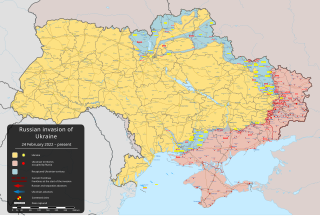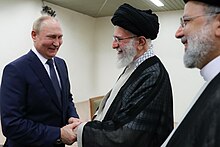
Relations between the Grand Duchy of Moscow and the Persian Empire (Iran) officially commenced in 1521, with the Safavids in power. Past and present contact between Russia and Iran have long been complicatedly multi-faceted; often wavering between collaboration and rivalry. The two nations have a long history of geographic, economic, and socio-political interaction. Mutual relations have often been turbulent, and dormant at other times.

Israel–Ukraine relations are foreign relations between Israel and Ukraine. Both countries recognized each other on 11 May 1949 as the Ukrainian SSR and established de jure diplomatic relations on 26 December 1991 when Ukraine became independent. Israel has an embassy in Kyiv. Ukraine has an embassy in Tel Aviv and a consulate-general in Haifa. There are 30,000 Ukrainians settled in Israel, while Ukraine has one of Europe's largest Jewish communities. Ukraine is also the first state, apart from Israel, to have had both a Jewish president and prime minister simultaneously.

The Shahed 129 is an Iranian single-engine medium-altitude long-endurance unmanned combat aerial vehicle (UCAV) designed by Shahed Aviation Industries for the Islamic Revolutionary Guard Corps (IRGC). The Shahed 129 is capable of combat and reconnaissance missions and has an endurance of 24 hours; it is similar in size, shape and role to the American MQ-1 Predator and is widely considered as one of the most capable drones in Iranian service.
Drone warfare is a form of aerial warfare or marine warfare using unmanned combat aerial vehicles (UCAV) or weaponized commercial unmanned aerial vehicles (UAV). The United States, United Kingdom, Israel, China, South Korea, Iran, Italy, France, India, Pakistan, Russia, Turkey, Ukraine and Poland are known to have manufactured operational UCAVs as of 2019.

The Russo-Ukrainian War is an ongoing international conflict between Russia and Ukraine, which began in February 2014. Following Ukraine's Revolution of Dignity, Russia annexed Crimea from Ukraine and supported pro-Russian separatists fighting the Ukrainian military in the Donbas war. The first eight years of conflict also included naval incidents, cyberwarfare, and heightened political tensions. In February 2022, Russia launched a full-scale invasion of Ukraine and began occupying more of the country.

United Nations Security Council Resolution 2231 was a 20 July 2015 resolution endorsing the Joint Comprehensive Plan of Action on the nuclear program of Iran. It sets out an inspection process and schedule while also preparing for the removal of United Nations sanctions against Iran. The 15 nations on the Security Council unanimously endorsed the resolution, which had been negotiated by the permanent members of the United Nations Security Council—China, France, Russia, the United Kingdom, and the United States—plus Germany, the European Union, and Iran.

A loitering munition is a kind of aerial weapon with a built-in munition (warhead), which can loiter around the target area until a target is located; it then attacks the target by crashing into it. Loitering munitions enable faster reaction times against hidden targets that emerge for short periods without placing high-value platforms near the target area and also allow more selective targeting as the attack can be changed mid-flight or aborted.

On 24 February 2022, Russia invaded Ukraine in an escalation of the Russo-Ukrainian War that started in 2014. The invasion became the largest attack on a European country since World War II. It is estimated to have caused tens of thousands of Ukrainian civilian casualties and hundreds of thousands of military casualties. By June 2022, Russian troops occupied about 20% of Ukrainian territory. From the 41 million population in January 2022, about 8 million Ukrainians had been internally displaced and more than 8.2 million had fled the country by April 2023, creating Europe's largest refugee crisis since World War II. Extensive environmental damage caused by the war, widely described as an ecocide, contributed to food crises worldwide.

During the 2022 Russian invasion of Ukraine, the Russian Armed Forces have launched several missile attacks over the city of Dnipro in Ukraine. These have led to dozens of fatalities and over a hundred injuries among the civilian population.
During the Russian invasion of Ukraine, several senior Russian politicians, including president Vladimir Putin, former president and prime minister Dmitry Medvedev, and foreign minister Sergey Lavrov, have made a number of statements widely seen as threatening the use of nuclear weapons. The possibility of Russia using tactical nuclear weapons, and the risk of broader nuclear escalation, has been widely discussed by commentators and in the media. Additionally, the Russian occupation of the Zaporizhzhia Nuclear Power Plant has led to a crisis over the safety of the plant and the risk of a nuclear disaster.

The HESA Shahed 136, or Geran-2 in Russian service, is an Iranian loitering munition in the form of an autonomous pusher-prop drone. It is designed and manufactured by HESA in association with Shahed Aviation Industries.
This timeline of the Russian invasion of Ukraine covers the period from 8 April 2022, when the area of heavy fighting shifted to the south and east of Ukraine, to 28 August 2022, the day before Ukraine announced the start of its Kherson counteroffensive.
This timeline of the Russian invasion of Ukraine covers the period from 29 August 2022, when Ukraine's Kherson counteroffensive started, to 11 November 2022 when Ukrainian troops retook Kherson. In between, Ukraine launched a successful counteroffensive in Kharkiv Oblast. Starting in October, Russia began a campaign of massive strikes against Ukrainian infrastructure.

Beginning in July 2022, a series of explosions and fires occurred on the Russian-occupied Crimean Peninsula from where the Russian Army had launched its offensive on Southern Ukraine during the Russian invasion of Ukraine. Occupied since 2014, Crimea was a base for the subsequent Russian occupation of Kherson Oblast and Russian occupation of Zaporizhzhia Oblast. The Ukrainian government has not accepted responsibility for all of the attacks.

During the autumn and winter of 2022–2023, Russia launched waves of missile and drone strikes against energy infrastructure as part of its invasion of Ukraine. The strikes targeted civilian areas beyond the battlefield, particularly critical power infrastructure, which is considered a war crime. By the end of 2023, Russian forces launched about 7,400 missiles and 3,900 Shahed drone strikes against Ukraine according to Ukrainian military officials.
The Shahed 131, or Geran-1 in Russian service, is an Iranian-made drone which came to prominence in October 2022 during the Russian invasion of Ukraine. It is powered by a Wankel engine model Shahed-783/788.

Aerial warfare in the Russian invasion of Ukraine began at dawn of 24 February 2022, with infantry divisions and armored and air support in Eastern Ukraine, and dozens of missile attacks across Ukraine. The first fighting took place in Luhansk Oblast near the village of Milove on the border with Russia at 3:40 am Kyiv time. The main infantry and tank attacks were launched in four spearhead incursions, creating a northern front launched towards Kyiv, a southern front originating in Crimea, a south-eastern front launched at the cities of Luhansk and Donbas, and an eastern front. Dozens of missile strikes across Ukraine also reached as far west as Lviv. Drones have also been a critical part of the invasion, particularly in regards to combined arms warfare. Drones have additionally been employed by Russia in striking Ukrainian critical infrastructure, and have been used by Ukraine to strike military infrastructure in Russian territory.
On 24 February 2022, Russia invaded Ukraine, escalating the Donbas War that began in 2014 into the Russo-Ukrainian War. Twenty-one months later, on 20 November 2023, Ukraine had cumulatively received over $44 billion in materiel aid from the United States and over $35 billion from other allies on a month-to-month basis. The aid is logistical and is provided by drawdown of existing materiel that is then delivered to Ukraine. As this materiel is expended, the allied industrial base has been gradually drawn in to supply Ukraine but had not been fully engaged as of November 2023.

Kyiv, the capital of Ukraine with around 2,950,000 residents, has been frequently targeted by the Russian Armed Forces during the Russian invasion of Ukraine.













